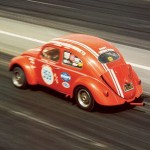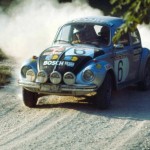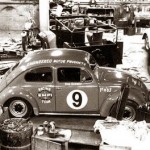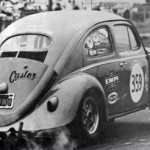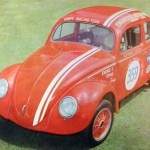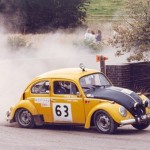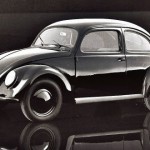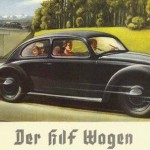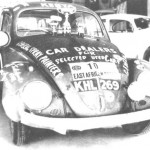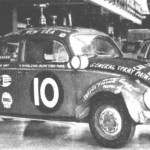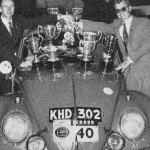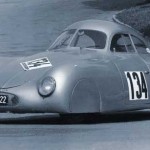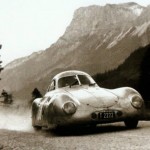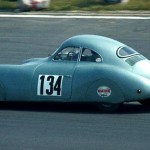Real-Life Herbies – Part 1
Who would have thought that Disney’s classic ‘The Love Bug’ is almost as good as a documentary? When compared with adventures of talking mice, winsome princesses and seven vertically-challenged miners, the tale of a 1200cc Volkswagen triumphing in drag races, road races and off-road events is remarkably unimaginative.
After designing cars of opulence and power for Daimler-Benz in the 1920s, Ferdinand Porsche embraced his engineer’s passion for minimalism when he founded his own automotive bureau in 1931. His first successful commission was the astonishing Auto Union V16 Grand Prix car, which used a lightweight rear-engined design in order to shoehorn its epically powerful 4.4-litre motor inside the 750kg maximum weight limit.
The mighty Auto Union begat much of Porsche’s next project: the KdF-Wagen. Having won the support of Adolf Hitler through the Auto Union programme, Porsche was commissioned to design a paragon of the Nazi ideology, a ‘people’s car’ in which the pure Aryan race could cruise Reich’s Autobahnen at 100 km/h to enjoy healthy outdoor pursuits and picnics.
It was the Auto Union which proved that putting the engine at the back gave better traction, saved on engineering costs and offered better use of space. The all-conquering 1936 ‘Type C’ Auto Union in which Bernd Rosemeyer defeated the mighty Mercedes-Benz squad also gave its front and rear suspension to the Volkswagen, making it close to a four-seat Grand Prix car as its 995cc motor would allow.
Of course the first 70,000 Volkswagens were neither competition cars nor celebrations of ‘Strength through Joy’ for Hitler’s Germany. They were utility vehicles for the army and air force in World War 2, mostly re-bodied with beefy suspension as kübelwagens or given four-wheel-drive and a propeller as amphibious schwimmwagens but also seen as ambulances, staff cars and other vital warhorses.
Among the many different iterations of the KdF-Wagen to be built in Nazi Germany, one was to be extremely influential. The Type 60K10 was a Volkswagen with a tuned-up 100hp motor and a sculpted coupe body which was designed to compete in the great events planned to take place in Hitler’s new world order. It ended up in obscurity would provide the foundations for Porsche’s post-war sports cars.
In 1945 Germany was beaten, Porsche was in prison and the KdF-Wagen factory was in ruins. The Volkswagen was derided by the automobile industry of the victorious Allied powers but within a decade the millionth ‘Beetle’ had rolled off the production line – while the car’s race-bred and rugged heritage began to make itself felt in competition.
The East African Coronation Safari Rally of 1953 was the starting point. Designed as a flat-out race to celebrate the coronation of Queen Elizabeth II, the rally crossed the roughest roads in Kenya, Uganda and Tanganyika. At an average speed of 43mph, victory fell to Alan Dix and Johnny Larsen in an 1131cc Volkswagen.
A total of four Safari Rally wins would fall to the humble Volkswagen, and throughout the 1950s more and more Beetles would appear in events as diverse as the Mille Miglia, Monte Carlo Rally and Carrera Panamericana. VW dealer Bill Bengry won the 1961 British rally championship in his own 1200cc road car. Then in 1963 the Beetle joined the American elite.
The Nassau Speed Week was a glamorous off-season gathering for the great and the good of both Europe and America. Amid the glamour and the girls, the Jaguars and Ferraris there arrived in 1963 a bright orange Volkswagen Beetle. From America.
Joe Vittone was one of the first VW dealers in America and had developed a neat line in replacement parts and tuning kits under the EMPI banner. Putting all his firm’s expertise into preparing his son Darrell’s 1956 Beetle and employing fellow Californian driver Dan Gurney, the EMPI Beetle caused a sensation in 1963-64.
The EMPI Beetle brought tuned-up Volkswagens to America and epitomized the low-slung, de-chromed ‘Californian Look’ that still dominates custom shows to this day. The original 1956 sedan also bequeathed its racing legacy and its distinctive stripes to Walt Disney’s new four-wheeled character, as the 1970s beckoned and, once again, Ferdinand Porsche’s utilitarian machine was preparing for new sporting successes.
by Nick Garton

